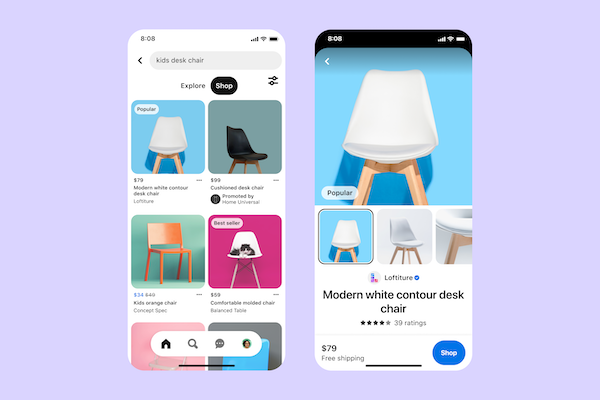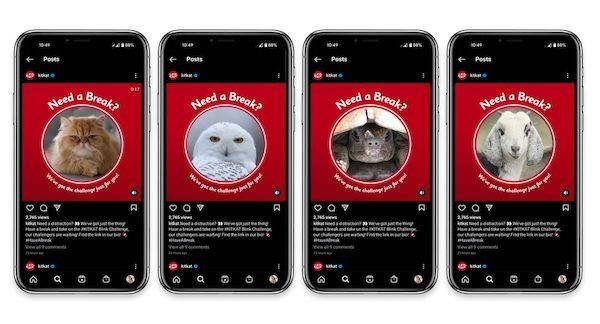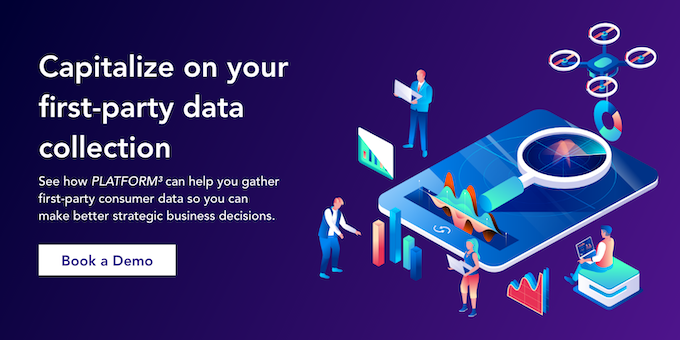How To Elevate Consumer Journeys With AI Marketing
With retail technology constantly expanding and evolving at a rapid pace, companies often find it difficult to keep up. From checkout-free shopping to text-to-order services, consumers are always looking for faster and more convenient ways to engage with their favorite brands. They also want to build deeper brand relationships through personalized content and messaging based on their data. To accomplish this, brands should strongly consider leveraging artificial intelligence in their marketing efforts. What is artificial intelligence, and how does it help marketers drive their consumers’ path to purchase?
What is artificial intelligence?
Artificial intelligence has had many definitions since its inception but is generally described as the combination of “computer science and robust datasets to enable problem-solving” - in other words, a computer system designed to think, act, and process information like a human being. The Turing Test, first proposed by Alan Turing in 1950, was one of the earliest milestones in artificial intelligence, seeking to determine whether a computer could be as smart as a human. Other famous AIs include IBM’s Watson, Baidu’s Minwa, and DeepMind’s AlphaGo.
There are two overall types of artificial intelligence: weak AI, also known as Narrow AI or Artificial Narrow Intelligence (ANI), and strong AI, which consists of Artificial General Intelligence (AGI) and Artificial Super Intelligence (ASI). Weak AI helps to perform specific tasks and is present in the majority of AI applications today, such as Apple's Siri and Amazon's Alexa. Strong AI is mostly theoretical, as it’s proposed to have superintelligence and its own consciousness. It’s currently only seen in science fiction, the most famous example being 2001: A Space Odyssey’s HAL 9000.
Machine learning vs. deep learning
When discussing artificial intelligence, people often include the terms “machine learning” and “deep learning”. Machine learning is a subset of artificial intelligence, where data models teach a computer what to do and how to learn on its own without instructions. Deep learning is a subset of machine learning, which uses much larger volumes of data and more detailed algorithms. Machine learning helps with things like data analytics, personalized recommendations, and image processing, while deep learning helps with more complex tasks like fraud detection and virtual assistance.
Artificial intelligence in marketing
Artificial intelligence is widely used across many different industries, including business, finance, manufacturing, and healthcare. It’s especially popular in retail, customer service, and sales and marketing. For example, retailers use AI to manage and optimize inventory, while support personnel use it to provide virtual assistance through chatbots and visual search. Finally, sales and marketing teams use AI to optimize sales strategies and ad campaigns, create predictive models and analytics reports, and develop personalized content and offers for consumers.
Currently, marketing AI is segmented into four different categories: stand-alone and integrated machine learning apps, and stand-alone and integrated task automation apps. Machine learning includes programmatic buying, ad optimization, and recommendation engines, while task automation includes simple functions like email workflows and basic chatbots. Stand-alone apps refer to channels that consumers have to specifically seek out, like a separate landing page that uses image processing to scan receipts. Integrated apps refer to channels already present in the buyer’s journey, such as a recommendation engine built into a brand’s website.
Benefits and challenges of AI marketing
Benefits of AI marketing
The main advantage of AI marketing is its ability to automate both routine operations and complex tasks. Rather than spending hours manually updating spreadsheets, sending emails, and optimizing strategies, artificial intelligence gives marketers more time to focus on other responsibilities. It’s also fast, convenient, and based on data and best practices, significantly reducing the amount of guesswork needed to make informed decisions.
Artificial intelligence is also constantly evolving, providing brands with an endless number of opportunities for growth. Instead of relying on older technologies that may eventually become outdated or even obsolete, companies can trust that AI will always continue to improve in terms of language modeling, interactive experiences, information processing, and more.
Lastly, artificial intelligence helps marketers increase their segmentation and personalization efforts. Consumers want their favorite brands to see and understand them as individuals with their own preferences, interests, and behaviors. Applications like chatbots can provide assistance based on their needs and buyer’s journey, while recommendation engines can suggest relevant products based on their search and purchase history. Without artificial intelligence, brands wouldn’t be able to provide the personalized experiences their consumers are looking for.
Challenges of AI marketing
The main disadvantage of artificial intelligence in marketing is the potential need for large amounts of resources, knowledge, and technical skill, even for basic things like chatbots. While AI helps streamline repetitive processes and simplify complex tasks, marketers still need to continuously create, manage, and update their AI workflows. Otherwise, they may end up sending the wrong email when sending automated messages, drawing the wrong conclusions when analyzing user data, and so on.
Another disadvantage of AI marketing is its current limitations when integrating with third-party platforms. For example, brands who create a mobile app that uses machine learning to serve personalized recommendations might not be able to replicate the same experience on their website or through their social content. Consumers are constantly seeking out omnichannel experiences where they can seamlessly move between a brand’s marketing channels, so these limitations can create friction on their path to purchase.
Lastly, consumers, governments, and regulatory organizations are becoming increasingly worried about personal privacy and data ownership. Many have expressed concerns over what and how their data gets collected, such as mobile apps that track their location or virtual assistants like Alexa that may be listening to their conversations. To build trust and transparency with their consumers, brands should only utilize zero-party and first-party data, which comes with users’ knowledge and consent. They also need to set clear policies on how to handle consumer data and let users have a certain degree of control over what information they provide and how their information is used.
AI marketing best practices
Establish consumer segmentation strategies
Brands should utilize artificial intelligence to group their potential and existing audiences based on shared similarities as a baseline for their personalized marketing campaigns. This can include basic demographics, such as their age group or location, and purchasing behaviors, such as their favorite products or retailers. Artificial intelligence can even create segments based on hyper-specific attributes that brands may not have identified otherwise. For example, an outdoor equipment manufacturer might use AI to separate camping experts from road trip fans or casual hikers from hiking enthusiasts, then create personalized content based on their needs and interests.
Leverage progressive profiling
Artificial intelligence is one of the best ways to capture and process large amounts of data. However, consumers are cautious about providing their personal information. Brands should strongly consider practicing progressive profiling to build deeper relationships with their consumers and collect more data for their marketing strategies at the same time. In progressive profiling, marketers ask consumers for small amounts of information over time, rather than requesting all of their data all at once. For example, when interacting with a chatbot, consumers might start by stating their intent, such as whether they’re in the research or purchase stage. The chatbot can then gather information about what they’re looking for, offer recommendations, and eventually collect contact details like their phone number and shipping address.
Outline privacy protection policies
To ease consumer and government concerns, brands need thorough vetting processes and privacy policies to ensure compliance with user protection laws. Whether they’re using chatbots, image processing, or facial recognition, marketers should avoid collecting, storing, and using consumer data without their explicit consent. They should also give consumers a degree of control over their information, such as requiring an opt-in before getting personalized recommendations based on their purchase history or letting them choose what types of automated email content they receive. This helps build trust and transparency between company and consumer.
Examples of AI marketing
Recently, Pinterest has been expanding their social commerce capabilities to become a top destination for consumers to research, discover, and purchase products. They use artificial intelligence to run their search engine and recommendation system, and recently acquired the AI-powered shopping platform, THE YES, to build on their existing efforts. Platforms like THE YES aim to provide “fully automated self-service and highly personalized shopping experiences”, using algorithms to learn more about consumers’ preferences over time, similar to streaming services like Spotify and Pandora.
Chatbots use a combination of machine learning and natural language processing (NLP) to automate marketing tasks and communicate with consumers. Whole Foods’s chatbot, first launched in 2016, helps shoppers find recipes based on dish types, cuisine, and special diets. They can search for recipes with multiple requirements, such as gluten-free appetizers or vegan Thai food, and can even search using nothing but emojis. For example, sending the corn, cheese, and peach emojis leads to a recipe for sweet corn soup with peaches.
Brands also use artificial intelligence to support their augmented reality (AR) and gamification efforts, creating more immersive customer experiences that improve engagement and brand recall. KitKat recently launched their AI-powered “Blink Break” campaign based on their famous “have a break, have a KitKat” slogan. When Instagram users come across the campaign, they’re invited to have a staring contest with a lineup of animals. The machine learning algorithm uses their phone camera to map their facial features and detect blinking. Users are also encouraged to share their results and invite others to participate via the #blinkchallenge hashtag.
Lastly, voice marketing has increased in popularity over the last decade or so, ranging from branded podcasts to audio-based social networks such as Clubhouse and Twitter Spaces. Companies also use artificial intelligence to provide services through voice assistants like Alexa and Google Home. Travel search engine Kayak launched a voice-enabled search feature via Alexa where users can look for flights, hotels and rental cars, get flight status updates, and make hotel reservations.
Leverage artificial intelligence through data-driven marketing campaigns
Artificial intelligence offers endless possibilities for more immersive and engaging brand experiences. Marketers can use AI applications like chatbots, recommendation engines, and more to boost awareness, sales, and customer loyalty. While artificial intelligence requires a certain level of time, skill, and resources, it can drive significant return on investment and customer lifetime value.
3 tier logic’s PLATFORM³ leverages artificial intelligence, first-party data, game mechanics, cryptography, and analytics to reach consumers through short-term marketing promotions and full-scale loyalty programs. Modules like Purchase Receipt Validation, Dynamic Messaging, Points & Gamification, and Data Capture & Analytics give brands the tools and insights they need to connect with consumers. To learn more, chat with an expert today.





